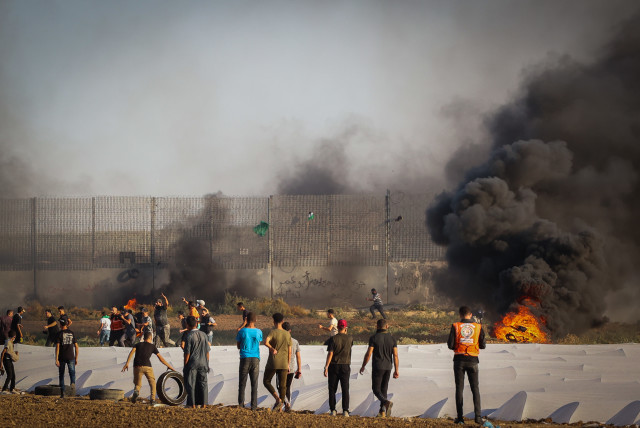Uncovering the failures in Israel’s response to the October 7 Hamas invasion - opinion

The October 7 Hamas invasion exposed severe shortcomings in Israel’s preparedness and response. Explore the multi-faceted responsibilities and lessons that must be addressed for a safer future.
Even before the blood dried and the embers were extinguished in the western Negev communities in the wake of the Hamas invasion and murderous rampage, Israel’s society was asking itself: how did the events of October 7 happen?
After all, following the 2005 Disengagement, Israel had been engaged in low-intensity fighting on the Gaza front in four rounds of engagements as well as constant intermittent incursions and other actions. This was not an all-quiet front.
A state-of-the-art anti-tunnel barrier was completed in March 2021. Designed to prevent Hamas attempts to infiltrate into southern Israel, it took three-and-a-half years to build. Fitted with sensors to detect tunnel construction and including remotely controlled weapons systems with an array of radar systems with cameras, it covered the entire territory of the Gaza Strip.
At the December 2021 ceremony marking its completion, then defense minister Benny Gantz said, “The barrier denies Hamas one of the capabilities it tried to develop and puts an iron wall, sensors, and cement between it and the citizens in the South. Ongoing normalcy of life here is our big victory.” But victory was denied.
Fence failure
As we witnessed, none of this really worked. Not the barrier which went down within minutes; not the technology that was made nonoperational within a few more minutes; not the communications system; not the surveillance balloons; not the scrambling of air or ground support; not the military intelligence higher up; and not the senior command, neither of the IDF nor of the Shin Bet (Israel Security Agency).
There were inadequate numbers of troops that could be called upon in the immediate emergency. There were standing orders that went unfulfilled. There were too many commanders on vacation, due to the holiday period. Previous intelligence field reports were pooh-poohed. Moreover, as the day went on, it was obvious that no one was that much in charge.
Response plans, if they at all existed for the possibility that something might go wrong, appeared to be useless. Above all, the deliberations of the previous evening, when warning signs were becoming apparent, proved indecisive.
In the month leading up to the Hamas invasion, there were indications that should have been considered foreboding.
Gazans had demonstrated at the border security fence. Leaders of Hamas and Islamic Jihad met in Beirut with the Iranian foreign minister and Hezbollah’s secretary-general. Hamas publicly emphasized it would continue to fight Israel in every arena.
Ongoing border assaults
On September 12, 2023, the joint operations room of the military-terrorist wings of the Palestinian organizations held a fourth “military” maneuver, which included live fire, rocket launches toward the sea, and a simulated attack on an Israeli position. Riots were renewed along the Gaza border, with Gazans throwing IEDs and hand grenades and launching incendiary balloons.
A second meeting was held in Beirut by the deputy head of Hamas’s political bureau, the secretary-general of Islamic Jihad, and the deputy secretary-general of the Popular Front for the Liberation of Palestine. They expressed publicly the importance of escalation and armed “resistance” against Israel.
There are multiple levels of responsibility for all of what happened. There is the strategic aspect of how the government conducted its various policies – diplomatic, political, and military – vis-à-vis Hamas. There was the tactical army preparation prior to, and on the day of, Oct. 7. There was the inability of the intelligence units to correctly analyze, assess, and present a fully rounded picture of, what Hamas was planning.
There were the crucial meetings and discussion of the evening of Oct. 6-7. Fifty years earlier, Israel’s government and army knew, a full day before, that war would most probably break out but made the decision to allow Egypt to strike the first blow. Last year, no one knew anything of Hamas’s plans and, more importantly, its capabilities, from paragliders to drone bombers.
National Security Council head Tzachi Hanegbi announced on Oct. 14, “I made a mistake when I said Hamas was deterred after [the 2021] Operation Guardian of the Walls.” As that opinion was based on what was provided him by the professionals, could it be that Prime Minister Benjamin Netanyahu was fooled by their reports, as Hanegbi was?
PM is at fault
Of course the prime minister bears responsibility, but for what exactly? The prime minister receives reports, updates, and assessments from the security heads. If they do not supply him with correct data or mislead him, and if those who are defense ministers see themselves as political rivals rather than sharing responsibility for the country’s security, then a major overhaul is in order.
Responsibility means the army cannot long continue with pre-October 7 senior officers in place. It does not mean that those who failed should appoint those who will replace them. An officer who resigned need not be reappointed, as just happened. October 7, as it unfolded, must never again occur.
Responsibility means that Israel’s citizens also need to own up to providing our enemies with the perception that our society is fractured and engaged in civil war. Protest, but don’t block main arteries with bonfires or throw sand at a minister or smack him on the head with a flagpole.
Responsibility means the good of the whole outweighs that of individuals because we need to care for the continuity of future generations. Being responsible means accepting that capitulating to Hamas’s demands is not the only choice.
Responsibility is also the recognition that the process that led up to the Oct. 7 debacle did not begin a few months or years earlier, but was the result of three decades of misguided diplomacy, beginning with the Oslo Accords and then continuing with the Disengagement. Former and present politicians and ministers – from Netanyahu to Ehud Barak, from Ehud Olmert to Tzipi Livni – are all involved to various degrees.
There is more than enough responsibility for all of us to share in.
The writer is a researcher, analyst, and opinion commentator on political, cultural, and media issues.
Jerusalem Post Store
`; document.getElementById("linkPremium").innerHTML = cont; var divWithLink = document.getElementById("premium-link"); if (divWithLink !== null && divWithLink !== 'undefined') { divWithLink.style.border = "solid 1px #cb0f3e"; divWithLink.style.textAlign = "center"; divWithLink.style.marginBottom = "15px"; divWithLink.style.marginTop = "15px"; divWithLink.style.width = "100%"; divWithLink.style.backgroundColor = "#122952"; divWithLink.style.color = "#ffffff"; divWithLink.style.lineHeight = "1.5"; } } (function (v, i) { });

